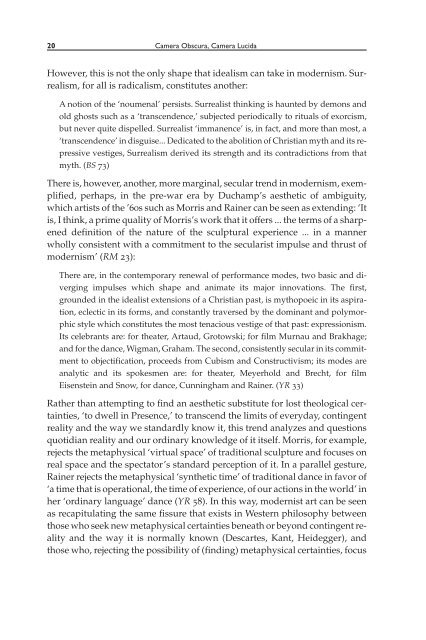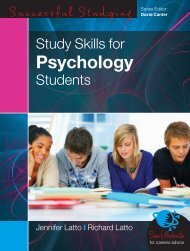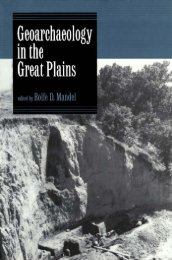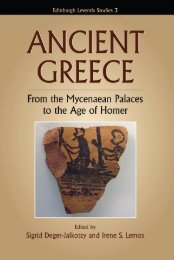- Page 1 and 2: FILM CULTURE IN TRANSITION CAMERA O
- Page 4 and 5: Camera Obscura, Camera Lucida: Essa
- Page 6 and 7: Contents Acknowledgements 7 Preface
- Page 8: Acknowledgements A number of indivi
- Page 11 and 12: 10 Camera Obscura, Camera Lucida
- Page 14 and 15: Introduction Malcolm Turvey Annette
- Page 16 and 17: Introduction 15 due to that critici
- Page 18 and 19: Introduction 17 Meanwhile, building
- Page 22 and 23: Introduction 21 on everyday reality
- Page 24 and 25: Introduction 23 ality’ could once
- Page 26 and 27: Introduction 25 generative, product
- Page 28 and 29: Introduction 27 sions between theor
- Page 30 and 31: Introduction 29 (KI 26). The functi
- Page 32 and 33: Introduction 31 early twentieth cen
- Page 34 and 35: WH ‘The Wings of Hypothesis: On M
- Page 36 and 37: The Logic of an Illusion Notes on t
- Page 38 and 39: The Logic of an Illusion 37 Accordi
- Page 40 and 41: The Logic of an Illusion 39 particu
- Page 42 and 43: The Logic of an Illusion 41 In his
- Page 44 and 45: The Logic of an Illusion 43 A man o
- Page 46 and 47: The Logic of an Illusion 45 cal inc
- Page 48 and 49: If a region A, then be so connected
- Page 50 and 51: The Logic of an Illusion 49 einer S
- Page 52 and 53: Narcissistic Machines and Erotic Pr
- Page 54 and 55: Narcissistic Machines and Erotic Pr
- Page 56 and 57: on the ramparts of the bourg. Her e
- Page 58 and 59: Narcissistic Machines and Erotic Pr
- Page 60 and 61: Narcissistic Machines and Erotic Pr
- Page 62 and 63: Narcissistic Machines and Erotic Pr
- Page 64 and 65: Narcissistic Machines and Erotic Pr
- Page 66 and 67: Narcissistic Machines and Erotic Pr
- Page 68 and 69: Narcissistic Machines and Erotic Pr
- Page 70 and 71:
Narcissistic Machines and Erotic Pr
- Page 72 and 73:
tional state, the specific fluctuat
- Page 74 and 75:
Narcissistic Machines and Erotic Pr
- Page 76 and 77:
Loïe Fuller and the Art of Motion
- Page 78 and 79:
Loïe Fuller and the Art of Motion
- Page 80 and 81:
Loïe Fuller and the Art of Motion
- Page 82 and 83:
Loïe Fuller and the Art of Motion
- Page 84 and 85:
Loïe Fuller and the Art of Motion
- Page 86 and 87:
Loïe Fuller and the Art of Motion
- Page 88 and 89:
every moment; or rather there is no
- Page 90:
Loïe Fuller and the Art of Motion
- Page 93 and 94:
92 Camera Obscura, Camera Lucida Hi
- Page 95 and 96:
94 Camera Obscura, Camera Lucida tu
- Page 97 and 98:
96 Camera Obscura, Camera Lucida si
- Page 99 and 100:
98 Camera Obscura, Camera Lucida co
- Page 101 and 102:
100 Camera Obscura, Camera Lucida T
- Page 103 and 104:
102 Camera Obscura, Camera Lucida T
- Page 105 and 106:
104 Camera Obscura, Camera Lucida M
- Page 107 and 108:
106 Camera Obscura, Camera Lucida 2
- Page 109 and 110:
108 Camera Obscura, Camera Lucida 4
- Page 111 and 112:
110 Camera Obscura, Camera Lucida F
- Page 113 and 114:
112 Camera Obscura, Camera Lucida k
- Page 115 and 116:
114 Camera Obscura, Camera Lucida F
- Page 117 and 118:
116 Camera Obscura, Camera Lucida t
- Page 119 and 120:
118 Camera Obscura, Camera Lucida F
- Page 121 and 122:
120 Camera Obscura, Camera Lucida P
- Page 123 and 124:
122 Camera Obscura, Camera Lucida f
- Page 125 and 126:
124 Camera Obscura, Camera Lucida i
- Page 127 and 128:
126 Camera Obscura, Camera Lucida 4
- Page 129 and 130:
128 Camera Obscura, Camera Lucida s
- Page 131 and 132:
130 Camera Obscura, Camera Lucida t
- Page 133 and 134:
132 Camera Obscura, Camera Lucida P
- Page 135 and 136:
134 Camera Obscura, Camera Lucida w
- Page 137 and 138:
136 Camera Obscura, Camera Lucida I
- Page 139 and 140:
138 Camera Obscura, Camera Lucida T
- Page 141 and 142:
140 Camera Obscura, Camera Lucida t
- Page 143 and 144:
142 Camera Obscura, Camera Lucida e
- Page 145 and 146:
144 Camera Obscura, Camera Lucida 1
- Page 147 and 148:
146 Camera Obscura, Camera Lucida 6
- Page 149 and 150:
148 Camera Obscura, Camera Lucida c
- Page 151 and 152:
150 Camera Obscura, Camera Lucida I
- Page 153 and 154:
152 Camera Obscura, Camera Lucida T
- Page 155 and 156:
154 Camera Obscura, Camera Lucida T
- Page 157 and 158:
156 Camera Obscura, Camera Lucida f
- Page 159 and 160:
158 Camera Obscura, Camera Lucida w
- Page 161 and 162:
160 Camera Obscura, Camera Lucida v
- Page 163 and 164:
162 Camera Obscura, Camera Lucida 9
- Page 165 and 166:
164 Camera Obscura, Camera Lucida t
- Page 167 and 168:
166 Camera Obscura, Camera Lucida i
- Page 169 and 170:
168 Camera Obscura, Camera Lucida l
- Page 171 and 172:
170 Camera Obscura, Camera Lucida t
- Page 173 and 174:
172 Camera Obscura, Camera Lucida t
- Page 175 and 176:
174 Camera Obscura, Camera Lucida a
- Page 177 and 178:
176 Camera Obscura, Camera Lucida k
- Page 179 and 180:
178 Camera Obscura, Camera Lucida A
- Page 181 and 182:
180 Camera Obscura, Camera Lucida p
- Page 183 and 184:
182 Camera Obscura, Camera Lucida 8
- Page 185 and 186:
184 Camera Obscura, Camera Lucida g
- Page 187 and 188:
186 Camera Obscura, Camera Lucida r
- Page 189 and 190:
188 Camera Obscura, Camera Lucida F
- Page 191 and 192:
190 Camera Obscura, Camera Lucida W
- Page 193 and 194:
192 Camera Obscura, Camera Lucida s
- Page 195 and 196:
194 Camera Obscura, Camera Lucida p
- Page 197 and 198:
196 Camera Obscura, Camera Lucida F
- Page 199 and 200:
198 Camera Obscura, Camera Lucida s
- Page 201 and 202:
200 Camera Obscura, Camera Lucida o
- Page 203 and 204:
202 Camera Obscura, Camera Lucida F
- Page 205 and 206:
204 Camera Obscura, Camera Lucida F
- Page 207 and 208:
206 Camera Obscura, Camera Lucida s
- Page 209 and 210:
208 Camera Obscura, Camera Lucida n
- Page 211 and 212:
210 Camera Obscura, Camera Lucida N
- Page 213 and 214:
212 Camera Obscura, Camera Lucida a
- Page 215 and 216:
214 Camera Obscura, Camera Lucida t
- Page 217 and 218:
216 Camera Obscura, Camera Lucida t
- Page 219 and 220:
218 Camera Obscura, Camera Lucida s
- Page 221 and 222:
220 Camera Obscura, Camera Lucida e
- Page 223 and 224:
222 Camera Obscura, Camera Lucida c
- Page 225 and 226:
224 Camera Obscura, Camera Lucida c
- Page 227 and 228:
226 Camera Obscura, Camera Lucida s
- Page 229 and 230:
228 Camera Obscura, Camera Lucida h
- Page 232 and 233:
Collection and Recollection On Film
- Page 234 and 235:
of this space. In the spirit of the
- Page 236 and 237:
Collection and Recollection 235 mon
- Page 238 and 239:
Collection and Recollection 237 mal
- Page 240 and 241:
Collection and Recollection 239 Fil
- Page 242 and 243:
Collection and Recollection 241 The
- Page 244 and 245:
Collection and Recollection 243 Alo
- Page 246 and 247:
Collection and Recollection 245 Arc
- Page 248 and 249:
tion, which both takes the place of
- Page 250 and 251:
Collection and Recollection 249 and
- Page 252 and 253:
Collection and Recollection 251 cur
- Page 254 and 255:
Collection and Recollection 253 cei
- Page 256 and 257:
Collection and Recollection 255 Sch
- Page 258 and 259:
Collection and Recollection 257 21.
- Page 260 and 261:
Collection and Recollection 259 55.
- Page 262 and 263:
Afterward: A Matter of Time Analog
- Page 264 and 265:
Afterward: A Matter of Time 263 Man
- Page 266 and 267:
Afterward: A Matter of Time 265 is
- Page 268 and 269:
Afterward: A Matter of Time 267 Cer
- Page 270 and 271:
Afterward: A Matter of Time 269 tha
- Page 272 and 273:
image, and the treatment of the two
- Page 274 and 275:
Afterward: A Matter of Time 273 7.
- Page 276 and 277:
Select Bibliography Books, as Edito
- Page 278 and 279:
Select Bibliography 277 ‘Bodies i
- Page 280 and 281:
Select Bibliography 279 ‘Lives of
- Page 282 and 283:
‘The Estates General of the Docum
- Page 284 and 285:
List of Contributors Richard Allen
- Page 286 and 287:
List of Contributors 285 University
- Page 288 and 289:
Brakhage, Stan 13, 20, 25, 27-28, 3
- Page 290 and 291:
Godard, Jean-Luc 149, 154-155, 159
- Page 292 and 293:
Mangolte, Babette 157 Manhatta (192
- Page 294 and 295:
Rousseau, Jean-Jacques 96 Ruiz, Rau
- Page 296 and 297:
Film Culture in Transition General






